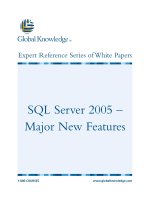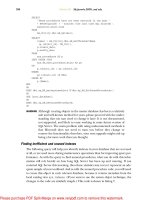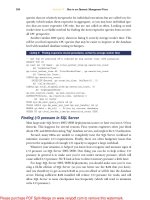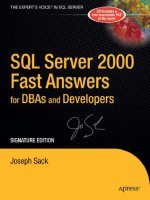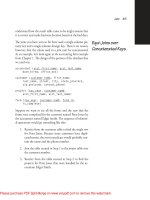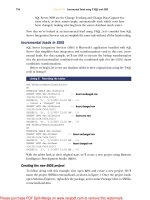Tài liệu SQL Clearly Explained- P4 pptx
Bạn đang xem bản rút gọn của tài liệu. Xem và tải ngay bản đầy đủ của tài liệu tại đây (411.62 KB, 50 trang )
String Manipulation 149
—includes rows for customers whose last names are made up
of the characters S-M-I-T-H, regardless of case. e UPPER
function converts the data stored in the database to uppercase
before making the comparison in the WHERE predicate. You
obtain the same eect by using LOWER instead of UPPER.
e TRIM function removes leading and/or trailing characters
from a string. e various syntaxes for this function and their
eects are summarized in Table 6-2.
You can place TRIM in any expression that contains a string.
For example, if you are using characters to store a serial num-
ber with leading 0s (for example, 0012), you can strip those 0s
when performing a search:
SELECT item_description
FROM items
WHERE TRIM (Leading ‘0’ FROM item_numb) = ‘25’
e SUBSTRING function extracts portions of a string. It has
the following general syntax:
SUBSTRING (source_string, FROM starting_posi-
tion FOR number_of_characters)
TRIM
Table 6-2: The various forms of the SQL TRIM function
Function Result Comments
TRIM (‘ word ‘) ‘word’
Default: removes both leading
and trailing blanks
TRIM (BOTH ‘ ‘ FROM ‘ word ‘) ‘word ’
Removes leading and trailing
blanks
TRIM (LEADING ‘ ‘ FROM ‘ word ‘) ‘word ’
Removes leading blanks
TRIM (TRAILING ‘ ‘ FROM ‘ word ‘) ‘ word’
Removes trailing blanks
TRIM (BOTH ‘*’ FROM ‘*word*’) ‘word’
Removes leading and trailing *
SUBSTRING
Please purchase PDF Split-Merge on www.verypdf.com to remove this watermark.
150 Chapter 6: Advanced Retrieval Operations
Mixed versus Single Case in Stored
Data
ere is always the temptation to require that text data be
stored as all uppercase letters to avoid the need to use UPPER
and LOWER in queries. For the most part, this isn’t a good
idea. First, text in all uppercase is dicult to read. Consider
the following two lines of text:
WHICH IS EASIER TO READ? ALL CAPS OR MIXED
CASE?
Which is easier to read? All caps or mixed
case?
Our eyes have been trained to read mixed upper- and lower-
case letters. In English, for example, we use letter case cues to
locate the start of sentences and to identify proper nouns. Text
in all caps removes those cues, making the text more dicult
to read. e “sameness” of all uppercase also makes it more dif-
cult to dierentiate letters and thus to understand the words.
For example, if the rare book store wanted to extract the rst
character of a customer’s rst name, the function call would
be written
SUBSTRING (first_name FROM 1 FOR 1)
e substring being created begins at the rst character of the
column and is one character long.
You could then incorporate this into a query with
SELECT SUBSTRING (first_name FROM 1 FOR 1)
|| ‘. ‘ || last_name AS whole_name
FROM customer;
Please purchase PDF Split-Merge on www.verypdf.com to remove this watermark.
Date and Time Manipulation 151
e results can be found in Figure 6-9.
SQL DBMSs provide column data types for dates and times.
When you store data using these data types, you make it pos-
sible for SQL to perform chronological operations on those
values. You can, for example, subtract two dates to nd out
the number of days between them or add an interval to a date
to advance the date a specied number of days. In this section
you will read about the types of date manipulations that SQL
provides along with a simple way to get current date and time
information from the computer.
e core SQL standard species four column data types that
relate to dates and times (jointly referred to as datetime data
types):
◊ DATE: A date only
◊ TIME: A time only
◊ TIMESTAMP: A combination of date and time
◊ INTERVAL: e interval between two of the preced-
ing data types
As you will see in the next two sections, these can be combined
in a variety of ways.
To help make date and time manipulations easier, SQL lets
you retrieve the current date and/or time with the following
three keywords:
◊ CURRENT_DATE: Returns the current system date
◊ CURRENT_TIME: Returns the current system time
◊ CURRENT_TIMESTAMP: Returns a combination of
the current system date and time
Date and Time
Manipulation
Date and Time
System Values
Please purchase PDF Split-Merge on www.verypdf.com to remove this watermark.
152 Chapter 6: Advanced Retrieval Operations
For example, to see all sales made on the current day, someone
at the rare book store uses the following query:
SELECT first_name, last_name, sale_id
FROM customer JOIN sale
WHERE sale_date = CURRENT_DATE;
You can also use these system date and time values when per-
forming data entry, as you will read about beginning in Chap-
ter 8.
SQL dates and times can participate in expressions that sup-
port queries such as “how many days/months/years in be-
tween?” and operations such as “add 30 days to the invoice
date.” e types of date and time manipulations available with
SQL are summarized in Table 6-3. Unfortunately, expressions
involving these operations aren’t as straightforward as they
might initially appear. When you work with date and time
intervals, you must also specify the portions of the date and/or
time that you want.
whole_name
J. Jones
J. Jones
J. Doe
J. Doe
J. Smith
J. Smith
H. Brown
H. Jerry
M. Collins
P. Collins
E. Hayes
F. Hayes
P. Johnson
P. Johnson
J. Smith
Figure 6-9: Output of a query including the SUBSTRING function
Date and Time
Interval Operations
Please purchase PDF Split-Merge on www.verypdf.com to remove this watermark.
Mixed versus Single Case in Stored Data 153
Each datetime column will include a selection of the following
elds:
◊ MILLENNIUM
◊ CENTURY
◊ DECADE
◊ YEAR
◊ QUARTER
◊ MONTH
◊ DAY
◊ HOUR
◊ MINUTE
◊ SECOND
◊ MILLISECONDS
◊ MICROSECONDS
Table 6-3: Datetime arithmetic
Expression Result
DATE ± integer DATE
DATE ± time_interval TIMESTAMP
DATE + time TIMESTAMP
INVERVAL ± INTERVAL INTERVAL
TIMESTAMP ± INTERVAL TIMESTAMP
TIME ± time_interval TIME
DATE – DATE integer
TIME – TIME INTERVAL
integer * INTERVAL INTERVAL
Please purchase PDF Split-Merge on www.verypdf.com to remove this watermark.
154 Chapter 6: Advanced Retrieval Operations
When you write an expression that includes an interval, you
can either indicate that you want the interval expressed in
one of those elds (for example, DAY for the number of days
between two dates) or specify a range of elds (for example,
YEAR TO MONTH to give you an interval in years and
months). e start eld (the rst eld in the range) can be
only YEAR, DAY, HOUR, or MINUTE. e second eld in
the range (the end eld) must be a chronologically smaller unit
than the start eld.
Note: ere is one exception to the preceding rule. If the start eld
is YEAR, then the end eld must be MONTH.
To see the number of years between a customer’s orders and
the current date, someone at the rare book store might use
SELECT CURRENT_DATE – sale_date YEAR
FROM sale
WHERE customer_numb = 6;
To see the same interval expressed in years and months, the
query would be rewritten as
SELECT CURRENT_DATE – sale_date YEAR TO MONTH
FROM sale
WHERE customer_numb = 6;
To add 7 days to an order date to give a customer an approxi-
mate delivery date, someone at the rare book store would write
a query like
SELECT sale_date + INTERVAL ‘7’ DAY
FROM sale
WHERE sale_id = 12;
Notice that when you include an interval as a literal, you pre-
cede it with the keyword INTERVAL, put the interval’s value
in single quotes, and follow it with the datetime unit in which
the interval is expressed.
Please purchase PDF Split-Merge on www.verypdf.com to remove this watermark.
Mixed versus Single Case in Stored Data 155
e SQL OVERLAPS operator is a special-purpose keyword
that returns true or false, depending on whether two date-
time intervals overlap. e operator has the following general
syntax:
SELECT (start_date1, end_date1)
OVERLAPS (start_date2, end_date2)
An expression such as
SELECT (DATE ’16-Aug-2013’, DATE ’31-Aug-2013’)
OVERLAPS
(DATE ’18-Aug-2013’, DATE ‘9-Sep-2013’);
produces the following result:
overlaps
t
Notice that the dates being compared are preceded by the key-
word DATE and surrounded by single quotes. Without the
specication of the type of data in the operation, SQL doesn’t
know how to interpret what is within the quotes.
e two dates and/or times that are used to specify an interval
can be either DATE/TIME/TIMESTAMP values or they can
be intervals For example, the following query checks to see
whether the second range of dates is within 90 days of the rst
start date and returns false:
SELECT (DATE ’16-Aug-2013’, INTERVAL ’90 DAYS’)
OVERLAPS
(DATE ’12-Feb-2013’, DATE ‘4-Jun-2013’);
Note: Because the OVERLAPS operator returns a Boolean, it can
be used as the logical expression in a CASE statement.
OVERLAPS
Please purchase PDF Split-Merge on www.verypdf.com to remove this watermark.
156 Chapter 6: Advanced Retrieval Operations
e EXTRACT operator pulls out a part of a date and/or
time. It has the following general format:
EXTRACT (datetime_field FROM datetime_value)
For example, the query
SELECT EXTRACT (YEAR FROM CURRENT_DATE);
returns the current year.
In addition to the datetime elds you saw earlier in this sec-
tion, EXTRACT also can provide the day of the week (DOW)
and the day of the year (DOY).
e SQL CASE expression, much like a CASE in a general
purpose programming language, allows a SQL statement to
pick from among a variety of actions based on the truth of
logical expressions. Like arithmetic and string operations, the
CASE statement generates a value to be displayed and there-
fore is part of the SELECT clause.
e CASE expression has the following general syntax:
CASE
WHEN logical condition THEN action
WHEN logical condition THEN action
:
:
ELSE default action
END
It ts within a SELECT statement with the structure found in
Figure 6-10.
e CASE does not necessarily need to be the last item in
the SELECT clause. e END keyword can be followed by a
comma and other columns or computed quantities.
EXTRACT
CASE
Expressions
Please purchase PDF Split-Merge on www.verypdf.com to remove this watermark.
CASE Expressions 157
As an example, assume that the rare book store wants to oer
discounts to users based on the price of a book. e more the
asking price for the book, the greater the discount. To include
the discounted price in the output of a query, you could use
SELECT isbn, asking_price,
CASE
WHEN asking_price < 50
THEN asking_price * .95
WHEN asking_price < 75
THEN asking_price * .9
WHEN asking_price < 100
THEN asking_price * .8
ELSE asking_price * .75
END
FROM volume;
e preceding query displays the ISBN and the asking price of
a book. It then evaluates the rst CASE expression following
WHEN. If that condition is true, the query performs the com-
putation, displays the discounted price, and exits the CASE.
If the rst condition is false, the query proceeds to the second
WHEN, and so on. If none of the conditions are true, the que-
ry executes the action following ELSE. (e ELSE is optional.)
SELECT column1, column2,
CASE
WHEN logical condition THEN action
WHEN logical condition THEN action
:
:
ELSE default action
END
FROM table(s)
WHERE predicate;
Figure 6-10: Using CASE within a SELECT statement
Please purchase PDF Split-Merge on www.verypdf.com to remove this watermark.
158 Chapter 6: Advanced Retrieval Operations
e rst portion of the output of the example query appears
in Figure 6-11. Notice that the value returned by the CASE
construct appears in a column named case. You can, however,
rename the computed column just as you would rename any
other computed column by adding AS followed by the desired
name.
e output of the modied statement—
SELECT isbn, asking_price,
CASE
WHEN asking_price < 50
THEN asking_price * .95
WHEN asking_price < 75
THEN asking_price * .9
WHEN asking_price < 100
THEN asking_price * .8
ELSE asking_price * .75
END AS discounted_price
FROM volume;
—can be found in Figure 6-12.
Please purchase PDF Split-Merge on www.verypdf.com to remove this watermark.
CASE Expressions 159
isbn | asking_price | case
+ +
978-1-11111-111-1 | 175.00 | 131.2500
978-1-11111-131-1 | 50.00 | 45.000
978-1-11111-137-1 | 80.00 | 64.000
978-1-11111-133-1 | 300.00 | 225.0000
978-1-11111-142-1 | 25.95 | 2465.25
978-1-11111-146-1 | 22.95 | 2180.25
978-1-11111-144-1 | 80.00 | 64.000
978-1-11111-137-1 | 50.00 | 45.000
978-1-11111-136-1 | 75.00 | 60.000
978-1-11111-136-1 | 50.00 | 45.000
978-1-11111-143-1 | 25.00 | 2375.00
978-1-11111-132-1 | 15.00 | 1425.00
978-1-11111-133-1 | 18.00 | 1710.00
978-1-11111-121-1 | 110.00 | 82.5000
978-1-11111-121-1 | 110.00 | 82.5000
978-1-11111-121-1 | 110.00 | 82.5000
Figure 6-11: Default output of a SELECT statement containing
CASE
isbn | asking_price | discounted_price
+ +
978-1-11111-111-1 | 175.00 | 131.2500
978-1-11111-131-1 | 50.00 | 45.000
978-1-11111-137-1 | 80.00 | 64.000
978-1-11111-133-1 | 300.00 | 225.0000
978-1-11111-142-1 | 25.95 | 2465.25
978-1-11111-146-1 | 22.95 | 2180.25
978-1-11111-144-1 | 80.00 | 64.000
978-1-11111-137-1 | 50.00 | 45.000
978-1-11111-136-1 | 75.00 | 60.000
978-1-11111-136-1 | 50.00 | 45.000
978-1-11111-143-1 | 25.00 | 2375.00
978-1-11111-132-1 | 15.00 | 1425.00
978-1-11111-133-1 | 18.00 | 1710.00
978-1-11111-121-1 | 110.00 | 82.5000
978-1-11111-121-1 | 110.00 | 82.5000
978-1-11111-121-1 | 110.00 | 82.5000
Figure 6-12: CASE statement output using a renamed column for the
CASE value
Please purchase PDF Split-Merge on www.verypdf.com to remove this watermark.
7
161
e queries you have seen so far in this book for the most part
operate on one row at a time. However, SQL also includes
a variety of keywords and functions that work on groups of
rows—either an entire table or a subset of a table. In this chap-
ter you will read about what you can do to and with grouped
data.
Note: Many of the functions that you will be reading about in this
chapter are often referred to as SQL’s OLAP (Online Analytical
Processing) functions.
e basic SQL set, or aggregate, functions (summarized in Table
7-1) compute a variety of measures based on values in a col-
umn in multiple rows. e result of using one of these set
functions is a computed column that appears only in a result
table.
e basic syntax for a set function is
Function_name (input_argument)
You place the function call following SELECT, just as you
would an arithmetic calculation. What you use for an input
argument depends on which function you are using.
Working with Groups
of Rows
Set Functions
©2010 Elsevier Inc. All rights reserved.
10.1016/B978-0-12-375697-8.50007-8
Please purchase PDF Split-Merge on www.verypdf.com to remove this watermark.
162 Chapter 7: Working with Groups of Rows
Table 7-1: SQL set functions
Function Meaning
Functions implemented by most DBMSs
COUNT
Returns the number of rows
SUM
Returns the total of the values in a column from a group of rows
AVG
Returns the average of the values in a column from a group of rows
MIN
Returns the minimum value in a column from among a group of
rows
MAX
Returns the maximum value in a column from among a group of
rows
Less widely implemented functions
COVAR_POP
Returns a population’s covariance
COVAR_SAMP
Returns the covariance of a sample
REGR_AVGX
Returns the average of an independent variable
REGR_AVGY
Returns the average of a dependent variable
REGR_COUNT
Returns the number of independent/dependent variable pairs
that remain in a population after any rows that have null in either
variable have been removed
REGR_INTERCEPT
Returns the Y-intercept of a least-squares-t linear equation
REGR_R2
Returns the square of the correlation coecient R
REGR_SLOPE
Returns the slope of a least-squares-t linear equation
REGR_SXX
Returns the sum of the squares of the values of an independent
variable
REGR_SXY
Returns the product of pairs of independent and dependent
variable values
REGR_SYY
Returns the sum of the square of the values of a dependent variable
STDDEV_POP
Returns the standard deviation of a population
STDDEV_SAMP
Returns the standard deviation of a sample
VAR_POP
Returns the variance of a population
VAR_SAMP
Returns the variance of a sample
Please purchase PDF Split-Merge on www.verypdf.com to remove this watermark.
Set Functions 163
Note: For the most part, you can count on a SQL DBMS support-
ing COUNT, SUM, AVG, MIN, and MAX. In addition, many
DBMSs provide additional aggregate functions for measures such
as standard deviation and variance. Consult the DBMSs docu-
mentation for details.
e COUNT function is somewhat dierent from other SQL
set functions in that instead of making computations based on
data values, it counts the number of rows in a table. To use it,
you place COUNT (*) in your query. COUNT’s input argu-
ment is always an asterisk:
SELECT COUNT (*)
FROM volume;
e response appears as
count
71
To count a subset of the rows in a table, you can apply a
WHERE predicate:
SELECT COUNT (*)
FROM volume
WHERE isbn = ‘978-1-11111-141-1’;
e result—
Count
7
—tells you that the store has sold or has in stock seven books
with an ISBN of 978-1-11111-141-1. It does not tell you
how many copies of the book are in stock or how many were
purchased during any given sale because the query is simply
counting the number of rows in which the ISBN appears. It
does not take into account data in any other column.
COUNT
Please purchase PDF Split-Merge on www.verypdf.com to remove this watermark.
164 Chapter 7: Working with Groups of Rows
Alternatively, the store could determine the number distinct
items contained in a specic order with a query like
SELECT COUNT (*)
FROM volume
WHERE sale_id = 6;
When you use * as an input parameter to the COUNT func-
tion, the DBMS includes all rows. However, if you wish to
exclude rows that have nulls in a particular column, you can
use the name of the column as an input parameter. To nd out
how many volumes are currently in stock, the rare book store
could use
SELECT COUNT (selling_price)
FROM volume;
If every row in the table has a value in the selling_date col-
umn, then COUNT (selling_date) is the same as COUNT
(*). However, if any rows contain null, then the count will
exclude those rows. ere are 71 rows in the volume table.
However, the count returns a value of 43, indicating that 43
volumes have not been sold and therefore are in stock.
You can also use COUNT to determine how many unique
values appear in any given column by placing the keyword
DISTINCT in front of the column name used as an input
parameter. For example, to nd out how many dierent books
appear in the volume table, the rare book store would use
SELECT COUNT (DISTINCT isbn)
FROM volume;
e result—27—is the number of unique ISBNs in the table.
If someone at the rare book store wanted to know the total
amount of an order so that value could be inserted into the
sale table, then the easiest way to obtain this value is to add up
the values in the selling_price column:
SUM
Please purchase PDF Split-Merge on www.verypdf.com to remove this watermark.
Set Functions 165
SELECT SUM (selling_price)
FROM volume
WHERE sale_id = 6;
e result appears as
sum
505.00
In the preceding example, the input argument to the SUM
function was a single column. However, it can also be an arith-
metic operation. For example, to nd the total of a sale if the
books are discounted 15 percent, the rare book store could use
the following query:
SELECT SUM (selling_price * .85)
FROM volume
WHERE sale_id = 6;
e result—
sum
429.2500
—is the total of the multiplication of the selling price times
the selling percentage after the discount.
If we needed to add tax to a sale, a query could then multiply
the result of the SUM by the tax rate:
SELECT SUM (selling_price * .85) * 1.0725
FROM volume
WEHRE sale_id = 6;
producing a nal result of 429.2500.
Note: Rows that contain nulls in any column involved in a SUM
are excluded from the computation.
Please purchase PDF Split-Merge on www.verypdf.com to remove this watermark.
166 Chapter 7: Working with Groups of Rows
e AVG function computes the average value in a column.
For example, to nd the average price of a book, someone at
the rare book store could use a query like
SELECT AVG (selling_price)
FROM volume;
e result is 68.2313953488372093 (approximately $68.23).
Note: Rows that contain nulls in any column involved in an AVG
are excluded from the computation.
e MIN and MAX functions return the minimum and maxi-
mum values in a column or expression. For example, to see
the maximum price of a book, someone at the rare book store
could use a query like
SELECT MAX (selling_price)
FROM volume;
e result is a single value: $205.00.
e MIN and MAX functions are not restricted to columns or
expression that return numeric values. If someone at the rare
book store wanted to seethe latest date on which a sale had
occurred, then
SELECT MAX (sale_date)
FROM volume;
returns the chronologically latest date (in our particular sam-
ple data, 01-Sep-13).
By the same token, if you use
SELECT MIN (last_name)
FROM customer;
you will receive the alphabetically rst customer last name
(Brown).
AVG
MIN and MAX
Please purchase PDF Split-Merge on www.verypdf.com to remove this watermark.
Changing Data Types: CAST 167
Set functions can also be used in WHERE predicates to gener-
ate values against which stored data can be compared. Assume,
for example, that someone at the rare book store wants to see
the titles and cost of all books that were sold that cost more
than the average cost of a book.
e strategy for preparing this query is to use a subquery that
returns the average cost of a sold book and to compare the cost
of each book in the volume table to that average:
SELECT title, selling_price
FROM work, book, volume
WHERE work.work_numb = book.work_numb
AND book.isbn = volume.isbn
AND selling_price > (SELECT AVG (selling_price)
FROM volume);
Although it would seem logical that the DBMS would calcu-
late the average once and use the result of that single computa-
tion to compare to rows in the volume, that’s not what happens.
is is actually an uncorrelated subquery; the DBMS recalcu-
lates the average for every row in volume. As a result, a query
of this type will perform relatively slowly on large amounts of
data. You can nd the result in Figure 7-1.
One of the problems with the output of the SUM and AVG
functions that you saw in the preceding section of this chapter
is that they give you no control over the precision (number of
places to the right of the decimal point) of the output. One
way to solve that problem is to change the data type of the
result to something that has the number of decimal places you
want using the CAST function.
CAST requires that you know a little something about SQL
data types. Although we will cover them in depth in Chapter
8, a brief summary can be found in Table 7-2.
Set Functions in
Predicates
Changing Data
Types: CAST
Please purchase PDF Split-Merge on www.verypdf.com to remove this watermark.
168 Chapter 7: Working with Groups of Rows
title | selling_price
+
Jane Eyre | 175.00
Giles Goat Boy | 285.00
Anthem | 76.10
Tom Sawyer | 110.00
Tom Sawyer | 110.00
Adventures of Huckleberry Finn, The | 75.00
Treasure Island | 120.00
Fountainhead, The | 110.00
I, Robot | 170.00
Fountainhead, The | 75.00
Giles Goat Boy | 125.00
Fountainhead, The | 75.00
Foundation | 75.00
Treasure Island | 150.00
Lost in the Funhouse | 75.00
Hound of the Baskervilles | 75.00
Figure 7-1: Output of a query that uses a set function in a subquery
Table 7-2: SQL data types for use with the CAST function
Data Type Arguments Explanation
DECIMAL (n, m)
n: Total length of number, including
decimal point;
m: number of digits to the right of the
decimal point
A signed oating point
number
INT
A signed integer
VARCHAR (n)
n: Maximum number of characters
allowed
A text value that can be
as large as the number of
characters actually stored, up
to the maximum specied
CHAR (n)
n: Maximum number of characters
allowed
A xed-length character value
DATE
A date
TIME
A time
TIMESTAMP
A combination date and time
value
Please purchase PDF Split-Merge on www.verypdf.com to remove this watermark.
Grouping Queries 169
CAST has the general syntax
CAST (source_data AS new_data_type)
To restrict the output of the average price of books to a preci-
sion of 2, you could then use
CAST (AVG (selling_price) AS DECIMAL (10,2))
and incorporate it into a query using
SELECT CAST (AVG (selling_price) AS DECIMAL
(10,2))
FROM volume;
e preceding species that the result should be displayed as a
decimal number with a maximum of 10 characters (including
the decimal point) with two digits to the right of the decimal
point. e result is 68.23, a more meaningful currency value
than the original 68.2313953488372093.
CAST also can be used, for example, to convert a string of
characters into a date. e expression
CAST (’10-Aug-2013’ AS DATE)
returns a datetime value.
Valid conversions for commonly used data types are represent-
ed by the light gray boxes in Table 7-3. ose conversions that
may be possible if certain conditions are met are represented
by the dark gray boxes. In particular, if you are attempting to
convert a character string into a shorter string, the result will
be truncated.
SQL can group rows based on matching values in specied col-
umns and computer summary measures for each group. When
these grouping queries are combined with the set functions
that you saw earlier in this chapter, SQL can provide simple
reports without requiring any special programming.
Grouping
Queries
Please purchase PDF Split-Merge on www.verypdf.com to remove this watermark.
170 Chapter 7: Working with Groups of Rows
To form a group, you add a GROUP BY clause to a SELECT
statement, followed by the columns whose values are to be
used to form the groups. All rows whose values match on those
columns will be placed in the same group.
For example, if someone at the rare book store wants to see
how many copies of each book edition have been sold, he or
she can use a query like
SELECT isbn, COUNT(*)
FROM volume
GROUP BY isbn
ORDER BY isbn;
Table 7-3: Valid data type conversion for commonly used data types (light gray boxes are valid; dark gray
boxes may be valid)
Original
data type
New Data Type
Integer
or xed
point
Floating
point
Variable
length
character
Fixed
length
character
Date Time Timestamp
Integer or
xed point
Floating
point
Character
(xed or
variable
length)
Date
Time
Timestamp
Forming Groups
Please purchase PDF Split-Merge on www.verypdf.com to remove this watermark.
Grouping Queries 171
e query forms groups by matching ISBNs. It displays the
ISBN and the number of rows in each group (see Figure 7-2).
ere is a major restriction that you must observe with a group-
ing query: You can display values only from columns that are
used to form the groups. As an example, assume that someone
at the rare book store wants to see the number of copies of each
title that have been sold. A working query could be written
isbn | count
+
978-1-11111-111-1 | 1
978-1-11111-115-1 | 1
978-1-11111-121-1 | 3
978-1-11111-122-1 | 1
978-1-11111-123-1 | 2
978-1-11111-124-1 | 1
978-1-11111-125-1 | 1
978-1-11111-126-1 | 3
978-1-11111-127-1 | 5
978-1-11111-128-1 | 1
978-1-11111-129-1 | 1
978-1-11111-130-1 | 4
978-1-11111-131-1 | 4
978-1-11111-132-1 | 3
978-1-11111-133-1 | 5
978-1-11111-135-1 | 1
978-1-11111-136-1 | 6
978-1-11111-137-1 | 4
978-1-11111-138-1 | 4
978-1-11111-139-1 | 4
978-1-11111-140-1 | 1
978-1-11111-141-1 | 7
978-1-11111-142-1 | 1
978-1-11111-143-1 | 1
978-1-11111-144-1 | 1
978-1-11111-145-1 | 3
978-1-11111-146-1 | 2
Figure 7-2: Counting the members of a group
Please purchase PDF Split-Merge on www.verypdf.com to remove this watermark.
172 Chapter 7: Working with Groups of Rows
SELECT title, COUNT (*)
FROM volume, book, work
WHERE volume.isbn = book.isbn
AND book.work_numb = work.work_numb
GROUP BY title
ORDER BY title;
e result appears in Figure 7-3. e problem with this ap-
proach is that titles may duplicate. erefore, it would be
better to group by the work number. However, given the re-
striction as to what can be displayed, you wouldn’t be able to
display the title.
e solution is to make the DBMS do a bit of extra work:
Group by both the work number and the title. e DBMS will
title | count
+
Adventures of Huckleberry Finn, The | 1
Anathem | 1
Anthem | 4
Atlas Shrugged | 5
Bourne Supremacy, The | 1
Cryptonomicon | 2
Foundation | 11
Fountainhead, The | 4
Giles Goat Boy | 5
Hound of the Baskervilles | 1
I, Robot | 4
Inkdeath | 7
Inkheart | 1
Jane Eyre | 1
Kidnapped | 2
Last Foundation | 4
Lost in the Funhouse | 3
Matarese Circle, The | 2
Snow Crash | 1
Sot Weed Factor, The | 4
Tom Sawyer | 3
Treasure Island | 4
Figure 7-3: Grouping rows by book title
Please purchase PDF Split-Merge on www.verypdf.com to remove this watermark.
Grouping Queries 173
then form groups that have the same values in both columns.
ere is only one title per work number, so the result will be
the same as that in Figure 7-3 if there are no duplicated titles.
We therefore gain the ability to display the title when grouping
by the work number. e query could be written
SELECT work.work_numb title, COUNT (*)
FROM volume, book, work
WHERE volume.isbn = book.isbn
AND book.work_numb = work.work_numb
GROUP BY work_numb, title
ORDER BY title;
As you can see in Figure 7-4, the major dierence between the
two results is the appearance of the work number column.
work_numb | title | count
+ +
9 | Adventures of Huckleberry Finn, The | 1
28 | Anathem | 1
30 | Anthem | 4
14 | Atlas Shrugged | 5
12 | Bourne Supremacy, The | 1
31 | Cryptonomicon | 2
23 | Foundation | 11
13 | Fountainhead, The | 4
20 | Giles Goat Boy | 5
3 | Hound of the Baskervilles | 1
25 | I, Robot | 4
27 | Inkdeath | 7
26 | Inkheart | 1
1 | Jane Eyre | 1
16 | Kidnapped | 2
24 | Last Foundation | 4
19 | Lost in the Funhouse | 3
11 | Matarese Circle, The | 2
29 | Snow Crash | 1
18 | Sot Weed Factor, The | 4
8 | Tom Sawyer | 3
17 | Treasure Island | 4
Figure 7-4: Grouped output using two grouping columns
Please purchase PDF Split-Merge on www.verypdf.com to remove this watermark.
174 Chapter 7: Working with Groups of Rows
You can use any of the set functions in a grouping query. For
example, someone at the rare book store could generate the
total cost of all sales with
SELECT sale_id, SUM (selling_price)
FROM volume
GROUP BY sale_id;
e result can be seen in Figure 7-5. Notice that the last line of
the result has nulls for both output values. is occurs because
those volumes that haven’t been sold have null for the sale ID
and selling price. If you wanted to clean up the output, remov-
ing rows with nulls, you could add a WHERE clause:
SELECT sale_id, SUM (selling_price)
FROM volume
WHERE NOT (sale_id IS NULL)
GROUP BY sale_id;
sale_id | sum
+
1 | 510.00
2 | 125.00
3 | 58.00
4 | 110.00
5 | 110.00
6 | 505.00
7 | 80.00
8 | 130.00
9 | 50.00
10 | 125.00
11 | 200.00
12 | 225.00
13 | 25.95
14 | 80.00
15 | 100.00
16 | 130.00
17 | 100.00
18 | 100.00
19 | 95.00
20 | 75.00
Figure 7-5: The result of using a set function in a grouping query
Please purchase PDF Split-Merge on www.verypdf.com to remove this watermark.
